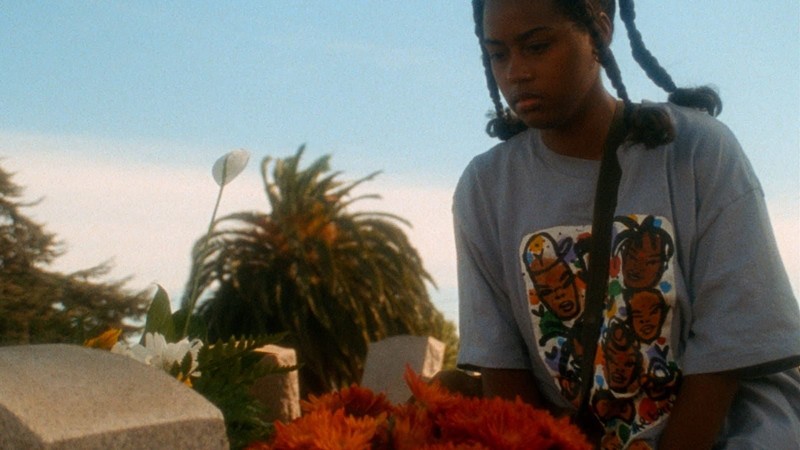One of film’s most obvious functions is of establishing a record, serving an essential archival function of documenting times, lives, moments, and places. Two welcome, newly restored works screening locally play to this strength of the medium and a good bit more this week, reworking in their own loose, productive ways the details of their respective directors’ own formative years. The first, Drylongso, arrives belatedly from the quite different Oakland, California, of 1998, where it was directed by Cauleen Smith — and plays at Cinema Detroit this Friday through Sunday. The other, Amir Naderi’s The Runner, from 1984, which screens at the Detroit Film Theatre, presents a diffuse patchwork of locations in Iran, set — despite its strained shooting circumstances — in a kind of assembled facsimile of the port city of Abadan, where its director lived out his early years.
Dealing head-on with the matter of shaping an understanding of one’s life through creative work, Drylongso casts a spotlight on Toby Smith as Pica, a young photography student and gig worker seeking a way to present work in a way that accounts for her own circumstances and voice. Skeptical and defiant of prospective mentors, she as much refuses as she struggles to fit in among both her classmates and family. In one key instance of this, Pica’s instructor, Mr. Yamada (Salim Akil, who also co-wrote the film) gently presses her to shoot her work on the more costly, lavish medium of 35mm film while she insists, even in the run-up to a showing of her work, on capturing her images on the more vernacular medium of Polaroid.
Itself shot in 16mm, Smith’s film doesn’t remotely resemble a Polaroid through the look of its images — but it does retain something of the medium’s offhand quality: the spirit if not the aesthetic. With just a few gestures structuring the film’s loose progression, the lead-up to Pica’s art showing metricizes the ambling experience of her own life but a neighborhood’s, too. Rife with squabbles, fights, and young romances, these individual and shared experiences take such precedence within Smith’s framing that they make a string of nighttime killings (a serial killer’s rumored to be the culprit) which weigh upon the main story feel essentially like a background plot.
Even with this figure’s impact not so much dramatized as deployed in a kind of shorthand for the threats which hover above and around Black lives, this violence lends an urgency to Pica’s art — and Smith’s film along with it. It creates a kind of pressure on the film’s efforts as both expression and document — with the subjects ranging from shadowy frames of porches at night to the too-bright lights of parties, or the emotionally worn face of a woman seated on the curb. Street photography plays a key role, too, making the film a kind of catalog of photography’s not-so-distant history and range of both vernacular and fine-art modes.
Seeming to work with just a few lights, Smith manages to produce indelible images with scant resources, banking on the skills of her cast and crew in not just creating a world but doing the equally difficult job of not showing their work, covering for the arduous nature of all the stuff involved. This sense of ease extends to the film’s fluid, sure direction, too; with great reliability, Smith populates her film with actors who seem both low-key yet irrepressibly themselves, knowing how to flatter them with a cut, a piece of music, a fade or a novel angle. Funny, frank, and wide-ranging in where it looks, Drylongso easily sells the work of portraiture as a lush variety of performance on its own, accomplishing, too, the elusive trick of making it look organic — almost as though her images were simply found.
Too sweeping in its use of geography to seem nearly so offhand, Amir Naderi’s The Runner spotlights 11-year old Amiro (Madjid Niroumand, giving a bright and charismatic performance) as he hustles for a living. Whether picking refuse from the local dump or from the sea, Amiro — while more than a viewer surrogate — doubles as a kind of witness to experiences of those on Iran’s margins, with global capital’s maritime machinery providing tantalizing hints at distant but present, cordoned-off ways of life. Forced to constantly struggle, and to favor sporadic work over any structured school, Amiro’s situation parallels Naderi’s own of being orphaned at a young age and finding ways to make a living while unhoused.
While Amiro seems, as a matter of necessity, as quick and agile in his negotiation of this lot as the film’s title might suggest, he remains — as does the movie with him — thoroughly preoccupied by potential sources of mobility. Barges, shipping containers, planes, trains, and bikes all feature; hurdles to access proving a defining feature across them. As he lives often aboard a rusty, grounded and abandoned boat, the disjunction between the impossibility of escape and the constant work involved in barely living become — to a starker degree than for most of us — the defining features of Amiro’s life.
Without veering into romanticism or glossing over struggle, Naderi shoots his film in a way that accounts carefully for the medium’s formal interplay of performance, pacing, and light. With pale, desaturated frames shot from a variety of locations in Iran (cobbled together to give an impression of a more concentrated, yet sprawling and varied geography than he worked on), the film’s oppressive circumstances wind up leavened by its director and characters’ thirst for variety. As a driving force, this never leaves the film — which proves a constant showcase for a vivid, tactile sense of engagement with a staggering range of environments. Without offering a defense or endorsement of the social realities which make it up, the film still declines to deny there’s something in them: making a kind of firsthand, thoroughly informed experiential case for the essential quality of what it shows.
Whether its characters — mostly children living, like Amiro, on their own — find themselves hitching rides, chasing trains, or caught up in scuffles, there’s a sensory immediacy to Naderi’s frames that’s courted through a ready observational engagement rather than the most standard-issue, telegraphing cinematic ways, such as through music cues or via the often through the sometimes maudlin spectacle of a close-up. Instead, Naderi tends toward long shots which capture his characters in a grounded context — offering the double benefit of catching not only their environment from scene to scene but their full, embodied postures and the emotional tones those convey. As a result, Naderi captures more — from both his settings and the people in them — than a Hollywood director working in the same place might, and the film is better for it.
Shot during the Iran-Iraq War (which features even less as a character than Drylongso’s killer), The Runner makes a like case for its own urgency — and does so without becoming a kind of “social problem” film. Instead, like Drylongso, it takes a level, good-humored look at its characters’ experiences, while retaining a clear vision, too, for the forces from which they arise. Never hectoring but always on the level, Smith and Naderi put trust in images as well as what they capture, knowing they’ll always make their own best case.
Coming soon: Metro Times Daily newsletter. We’ll send you a handful of interesting Detroit stories every morning. Subscribe now to not miss a thing.
Follow us: Google News | NewsBreak | Reddit | Instagram | Facebook | Twitter







